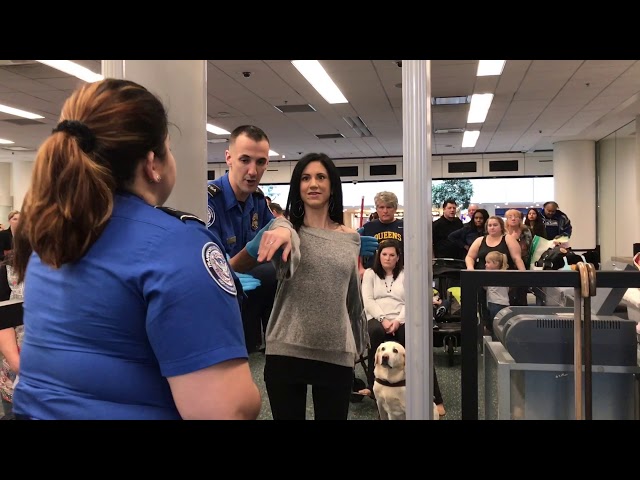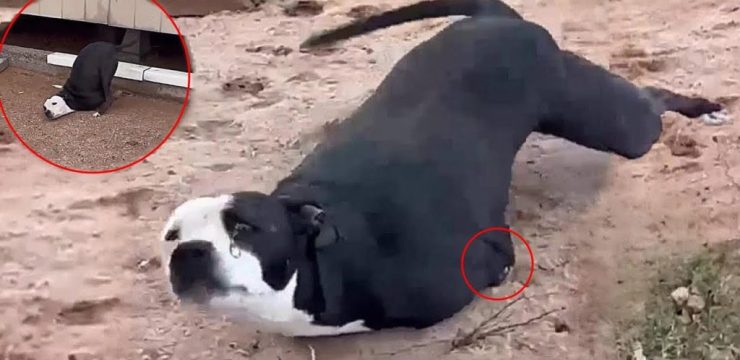Traveling by air can be stressful for anyone, with long lines, strict security checks, and the constant rush to catch flights. For travelers with visual impairments, however, the experience can be even more challenging. From navigating crowded terminals to following TSA procedures, every step requires precision, patience, and trust. That’s where remarkable guide dogs like Antonia come in—offering not just guidance but independence, safety, and peace of mind.
Antonia, a highly trained guide dog, is more than a travel companion—she’s an expert at helping her handler navigate complex environments like airports. Together, they demonstrate how teamwork, preparation, and understanding can turn a potentially overwhelming experience into a seamless journey. Let’s explore how Antonia and her handler move through the airport, handle security checkpoints, and make air travel accessible and empowering for visually impaired passengers.

The Journey Begins: Preparing for Travel
Preparation starts long before arriving at the airport. For visually impaired travelers, planning every detail in advance makes all the difference. Antonia’s handler reviews the flight itinerary, calls the airline to request disability assistance, and confirms that the airport staff will be available to help if needed. Meanwhile, Antonia is prepared with her harness, identification tag, and service animal credentials.
Airlines in the United States are required by law under the Air Carrier Access Act to accommodate passengers with service animals. This means Antonia can stay with her handler throughout the journey, including during check-in, boarding, and the flight itself. The key is communication—informing the airline in advance ensures that everyone involved, from security personnel to flight attendants, understands how to support the traveler and their guide dog effectively.
Arriving at the Airport: A Test of Trust and Focus
Airports are noisy, crowded, and full of distractions—an environment that can easily confuse even the most experienced traveler. For Antonia, however, it’s just another opportunity to demonstrate her training and calm focus. As they enter the terminal, she leads her handler around obstacles, avoids people rushing by, and locates important areas like check-in counters and restrooms.
Many airports now have designated service animal relief areas, making it easier for guide dogs to stay comfortable during long waits. Antonia knows exactly how to find these spaces when prompted, and her handler makes sure she gets time to rest and drink water before heading to the security checkpoint.
The Security Screening: Where Teamwork Shines
Airport security can be intimidating for anyone—but for travelers with visual impairments, it requires trust, coordination, and clear communication. The Transportation Security Administration (TSA) has specific guidelines for passengers with service animals, designed to make the process safe and efficient for both the traveler and the dog.
When Antonia and her handler approach the checkpoint, TSA officers are notified that she is a service animal. The handler removes metal items that could trigger alarms and prepares to walk through the metal detector. Antonia walks closely beside her handler, and if necessary, officers conduct a gentle hand inspection rather than separating them.
One of the most important rules is that a service animal should never be separated from its handler during screening. TSA agents are trained to respect this, ensuring that Antonia remains by her partner’s side at all times. Once cleared, Antonia receives a quiet verbal cue—a simple “Good girl”—and they continue toward the gate, confident and composed.
Boarding the Flight: Staying Calm and Comfortable
Once past security, Antonia and her handler navigate toward the gate area. Airline staff often assist with boarding, allowing passengers with service animals to enter first. This helps Antonia find her place before the plane fills with passengers.
Inside the aircraft, Antonia usually lies at her handler’s feet, staying calm and out of the aisle. Flight attendants make sure she has enough space and water if needed. Throughout the flight, she remains quiet and relaxed, responding only to her handler’s commands. It’s a level of discipline that comes from years of specialized training—guide dogs like Antonia learn how to adapt to various environments, from bustling airports to small airplane cabins.
Passengers nearby often admire her composure. While it’s natural to want to pet or talk to a service dog, it’s essential to remember that Antonia is working. Her focus is on her handler’s safety, and distractions could interfere with her ability to perform her job. Respecting this boundary allows her to stay alert and reliable throughout the journey.
Arriving at the Destination: Completing the Mission
After landing, Antonia guides her handler through the deplaning process and toward baggage claim or connecting transportation. Many airports provide additional support staff to ensure passengers with disabilities can navigate smoothly. With Antonia leading confidently, her handler walks through the bustling terminal, trusting every movement of her loyal partner.
Whether it’s locating the exit, finding an elevator, or identifying the correct ride-share pickup zone, Antonia’s guidance is invaluable. Her ability to recognize familiar cues and respond to subtle directions ensures a safe and efficient end to the journey.
The Importance of Training and Partnership
Antonia’s ability to perform these complex tasks doesn’t happen by chance—it’s the result of years of training and a deep bond with her handler. Guide dogs undergo rigorous preparation, learning to respond to hundreds of commands, avoid hazards, and maintain composure under pressure. They’re trained not just to follow instructions, but to think critically and make independent decisions when safety is at stake.
Equally important is the relationship between the guide dog and handler. Trust is at the heart of everything they do. The handler learns to interpret subtle signals from the dog—like a change in pace or direction—that might indicate an obstacle ahead. This silent communication builds a partnership stronger than words, one that transforms travel from a daunting challenge into a manageable adventure.
A Broader Message: Accessibility and Awareness
Antonia’s story isn’t just about one traveler and her dog—it highlights the broader importance of accessibility and inclusion in modern travel. Airports and airlines around the world are making strides toward becoming more disability-friendly, but awareness remains key.
By understanding how service animals work and respecting the needs of visually impaired passengers, fellow travelers and staff contribute to a more inclusive travel experience for everyone. Simple gestures—like offering clear verbal directions, avoiding unnecessary distractions for the guide dog, or giving space during boarding—can make a significant difference.
Empowerment Through Independence
At the heart of Antonia’s journey lies a powerful truth: independence doesn’t mean doing everything alone—it means having the right support to live freely and confidently. For her handler, Antonia represents more than a guide; she’s a bridge to the world, a symbol of empowerment and dignity.
Through patience, training, and compassion, guide dogs like Antonia redefine what it means to travel with confidence. Their presence reminds us that accessibility isn’t just a convenience—it’s a right. And with every step they take together, they show that the sky is open to everyone, no matter the challenges they face.





